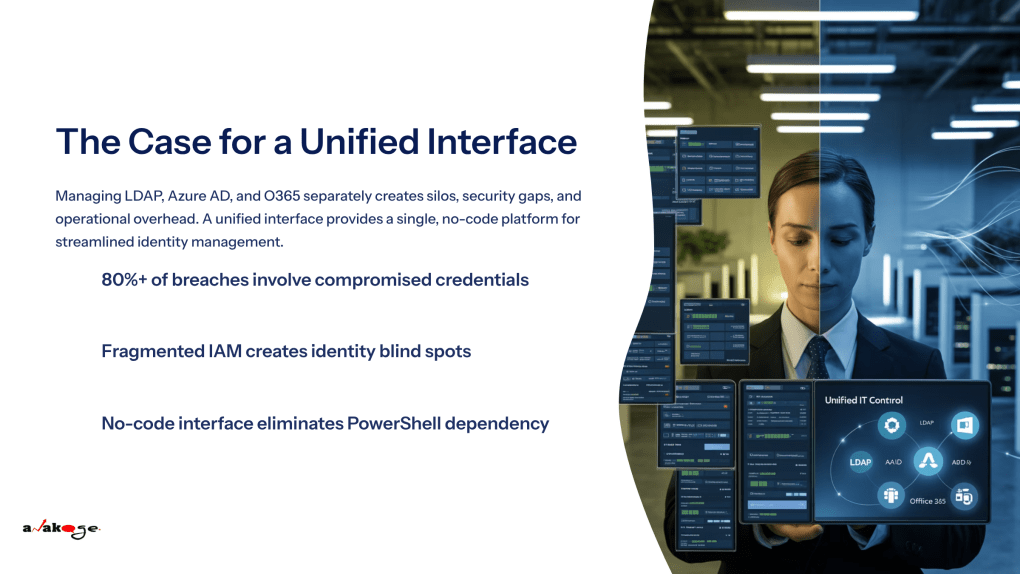Contents
- 1 The Case for a Unified Interface for LDAP, Azure AD, and O365
- 1.1 Introduction
- 1.2 The Fragmentation Problem: Why Multiple Consoles Create Risk and Complexity
- 1.3 Identity as the New Security Perimeter in 2025
- 1.4 What a Unified Interface Must Deliver
- 1.5 The Anakage Advantage: Unified, No-Code AD Automation
- 1.6 High-Impact Use Cases for IT Leaders
- 1.7 ROI Snapshot: Efficiency, Security, and Compliance
- 1.8 Deployment Path: Moving Towards Unified IAM
- 1.9 Conclusion
- 1.10 FAQ
The Case for a Unified Interface for LDAP, Azure AD, and O365
Introduction

The Fragmentation Problem: Why Multiple Consoles Create Risk and Complexity
Most enterprises operate across multiple directories. Legacy applications often depend on LDAP, while modern workflows rely on Azure AD and O365. Managing them in silos creates unnecessary complexity.
IT teams must switch between different consoles, each with its own configurations and limitations. This slows down routine tasks like user provisioning, group management, and deprovisioning. In many organizations, PowerShell scripts are used to bridge the gap. While powerful, this approach introduces bottlenecks since only a few IT specialists can write and maintain these scripts. It also increases the attack surface, as PowerShell misuse is a common tactic in credential-based attacks.
The result is inefficiency and risk. Delays in offboarding create orphaned accounts that attackers can exploit. Inconsistent policies across environments weaken compliance. And every manual step increases the chance of error.
Identity as the New Security Perimeter in 2025
Industry data shows that identity is now the primary target for cyberattacks. Over 80% of breaches involve compromised credentials, and most IT leaders expect an identity-related incident within the year. Once attackers gain access through a single account, they can escalate privileges and move laterally across systems.
Fragmented IAM only worsens this exposure. When directories are managed in isolation, visibility is limited. Threats like privilege creep, stale accounts, and misaligned permissions often go unnoticed. In an era where hybrid IT is the norm, organizations cannot afford identity blind spots.
What a Unified Interface Must Deliver
For IT leaders evaluating solutions, a unified interface should go beyond cosmetic integration. It must simplify operations and strengthen governance. Key capabilities include:
- Multi-domain support across LDAP, Azure AD, and O365.
- Bulk operations for provisioning and deprovisioning users.
- Role-based access control (RBAC) for safe delegation.
- Real-time validation and error handling to avoid misconfigurations.
- Secure APIs to integrate HR and ITSM workflows.
- Comprehensive audit logs and compliance-ready reporting.
- Self-service enablement without exposing sensitive Active Directory consoles.
The Anakage Advantage: Unified, No-Code AD Automation
Anakage addresses these challenges with a unified interface purpose-built for enterprise IAM.
- Single pane of glass: Manage LDAP, Azure AD, and O365 without switching between consoles.
- No scripting required: All operations are performed through an intuitive, no-code interface, eliminating dependency on PowerShell.
- Integrated JML workflows: Onboarding, role changes, and offboarding are automated to ensure consistency and speed.
- Bulk provisioning: Large-scale user and group operations are streamlined through easy-to-use templates.
- RBAC and audit trails: Delegation is secure, with full visibility into every action taken.
- Native ITSM integration: Identity operations can be triggered directly from service tickets, ensuring compliance and process alignment.
With these features, IT teams can standardize identity management across hybrid environments and minimize risks tied to manual or fragmented operations.
High-Impact Use Cases for IT Leaders
A unified interface is not just a technical convenience. It directly impacts key business workflows:
- Onboarding (Joiners): Create accounts across LDAP, Azure AD, and O365 instantly, ensuring new hires are productive on day one.
- Role Changes (Movers): Update group memberships and access privileges automatically when employees shift roles.
- Offboarding (Leavers): Revoke all access immediately, closing the window for security incidents.
- Bulk Operations: Handle department-wide changes in minutes rather than days.
- Access Hygiene: Identify and remove orphaned accounts, inactive groups, and other compliance risks.
ROI Snapshot: Efficiency, Security, and Compliance
Unifying IAM through Anakage brings measurable benefits.
- Reduced IT overhead: No scripting expertise is required, freeing skilled staff for higher-value tasks.
- Risk reduction: Accounts are managed consistently, reducing the likelihood of breaches tied to credential misuse.
- Faster resolution: Onboarding and offboarding take minutes instead of days.
- Compliance readiness: Detailed audit logs support regulations such as SOX, HIPAA, and GDPR.
- Cost efficiency: Automation translates to significant savings compared to manual management.
Deployment Path: Moving Towards Unified IAM
Organizations can take a phased approach to adopting a unified interface:
- Phase 1: Centralize basic AD actions such as user and group management.
- Phase 2: Integrate workflows with HR and ITSM systems.
- Phase 3: Expand automation to cover bulk operations and access hygiene.
- Phase 4: Enable delegated access for HR or support teams using RBAC.
This gradual rollout ensures business continuity while delivering quick wins in efficiency and security.
Conclusion
Fragmented identity management across LDAP, Azure AD, and O365 is no longer sustainable. It slows IT teams, introduces compliance risks, and leaves organizations exposed to attacks. A unified, no-code interface simplifies operations, enhances security, and ensures governance across all environments.
As highlighted in the 2025 Guide to No-Code Identity and Access Management (IAM) Automation, unifying IAM is not just about efficiency. It is a strategic priority for every enterprise building a secure, scalable, and future-ready IT foundation.
Next Step:
[Schedule a Personalized Demo Today]
Have you read about our last release? Click here to read!
FAQ
Why not just use PowerShell?
PowerShell requires specialized skills, introduces security risks, and creates dependency on a small set of experts.
How does this integrate with ITSM tools?
Anakage offers native integration and secure APIs for connecting with existing ITSM platforms.
Can HR or support teams use this safely?
Yes. RBAC ensures they only have access to the actions relevant to their roles.
What about hybrid environments?
The unified interface is designed for both on-premises and cloud directories, making it suitable for hybrid IT.